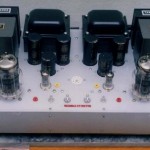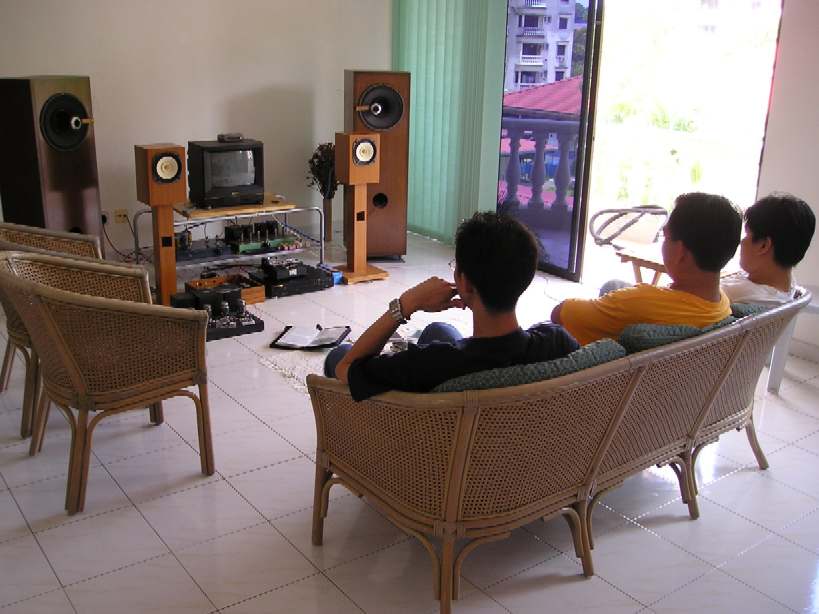Probably the most impressive audio innovation in the last 50 years!
Tripath – Class T Amp
The sad thing about audio is that, over the last 50 years, we have not seen much innovation. Amp circuitry is still variations of the same circuitry used years ago. The unsuspecting public may think that paying loads of moolah for a high end marque is justified as “these firms spend a lot of resources for R&D” but what R&D do you see? Maybe I’m blind but all I see is cosmetic audio jewellery like stainless steel chassis, boutique binding posts, blue LEDs… Better material have been used for passive components but the heart of the sound — the circuit — hasn’t seen much change. Why heck, my hairline and waistline has seen more changes in the last 5 years!
However, one of the very very few innovation(s) in amp designs that I could think of is switching amps. Initially, it didn’t enjoy a bright start and was widely panned by the audio mainstream. But look at it today!
How I got hooked…
A few months ago, I was sent an amp kit from this super-nice guy, Jan Fredriksson. Now, in addition to running “The Thiele-Small Loudspeaker Database”, Jan also runs www.41hz.com and it is through the later that he sells this Tripath magic to us DIYers! By the way, Jan also asked me to try out his kit. Of course I agreed! I’m also a nice guy, remember?
I got the kit way back … err… October ’04 I think, but never got around to building it until late November. Now Jan has made it very easy for DIYers with his very nicely done PCB but you got to have steady hand, nerves and heart to solder all those surface mount components. If you have a cold, don’t start work! Once you sneeze… you won’t stand a chance finding those dastardly tiny components! It helps too if you have IPA to clean up solder flux. I had some problems with this. More later…
Now, the kit I was sent is the AMP1 kit with components. It consists of all those teeny weeny SMT components, their bigger through-hole brothers, connectors, the beautiful PCB and of course, the Tripath TA2022 chip. Size is just slightly bigger than a credit card and it packs a muscular 60W into 8ohm and 100W into 4ohm! And I thought only Mighty Mouse packs so much power into such a small package!
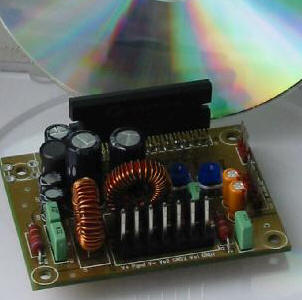
Tripath TA2022
You may ask why DIY when one can buy the Sonic Impact amp for USD20? Well, the Sonic Impact amp uses a different chip (TA2024) which gives up at ~15W. The Tripath TA2022 chip not only puts out more power (2x100W), it’s THD doesn’t rise as you increase the power (the smaller chip used in the Sonic Impact amp does). Why heck, just the TA2022 chip alone is more expensive than the Sonic Impact amp! Commercial amps like the Carver ZR1600 and the Bel Canto Design EVo 200.2, which retail in the USD1-2k range, use the larger 2x300W TK2350 which is also available from Jan in his AMP2 kit.
Read a comparison between the different Tripath chipsets here.
Detour
Have you ever failed a DIY project? You know, instead of beautiful music, all you got is a loud bang and lots of smoke? Well, if you experienced this before, welcome to the club!
I soldered all the SMT components without problems but when it came to building the +/-30VDC supply… I’m a big time charlie! I feel I should be running diy-green-horn.com instead. Yeah, I heard a loud bang! I saw smoke!!!!
For some reasons, I kept on having problems building the power supply. First I managed to get +30VDC, but when I built -30VDC, bang! Then as I debugged, I got -50V! Another bang!
After a while, I gave up [*shame! shame!*] and did the next best thing I could: seek help. And who else but our famous DAC Man! And our hero completed in just 2 days! And even drilled my chassis for me! So if you ever feel bad about not completing a DIY project, don’t worry, look at that idiot yeo guy!
Moving on…
Liew’s craftsmanship is evident here. Don’t think I can ever build an amp so neat like this. From R-L: 200VA trans, +30VDC and -30VDC supplies and the AMP1. Chassis is a tissue box made from Malaysian rubber wood. My pathetic attempt to be patriotic…
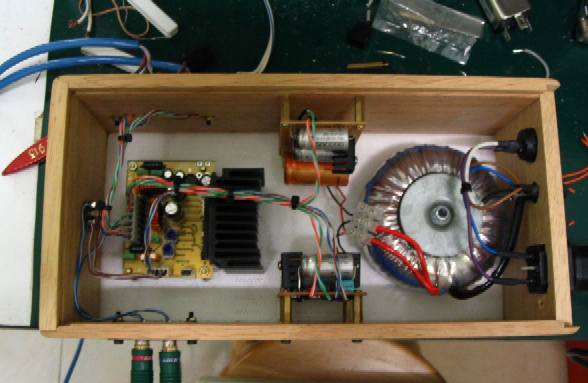
Here’s a picture of Liew’s test speakers feeling the full force of 60W.

Here’s a picture of my Coral Flat 6s, first time driven by more than 0.6W…
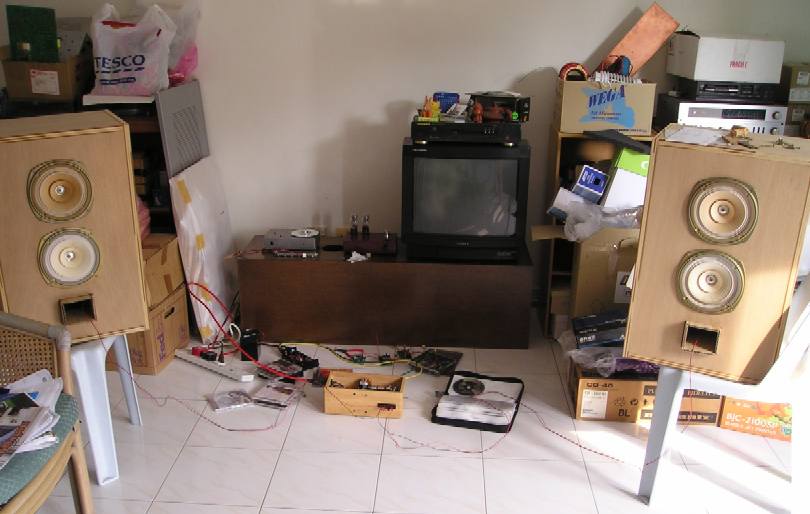
Other than building +/-30VDC supplies for me, Liew also helped me debug the amp. It was pulsing initially but Liew later discovered some solder flux seeped into neighbouring traces and caused problems. After desoldering those components, cleaning up the board with IPA, here comes music!

Okay, the sound?
To be honest, I’m suprised by how good it is. I’m sure most folks have read those reviews on 6moons.com and tnt.audio but nothing beats experiencing it yourself.
I’m suprised to find that it is very very quiet and has a dark dark background. Smooth, easy going and light on the foot, it also has a thickkkkkk midrange which should appeal to those that love “thick, warm” vocals. Tonally I can’t find anything obtrusive or irritating YET. But all this findings is preliminary as it has seen only 5 hours of play time! I believe this is enough to show how much potential this amp has! As it clocks more hours, I’ll let you know how it sounds.
Thanks to Jan for making this kit available to us DIYers and thanks for the excellent technical support!
Thanks to Liew for saving my arse!




